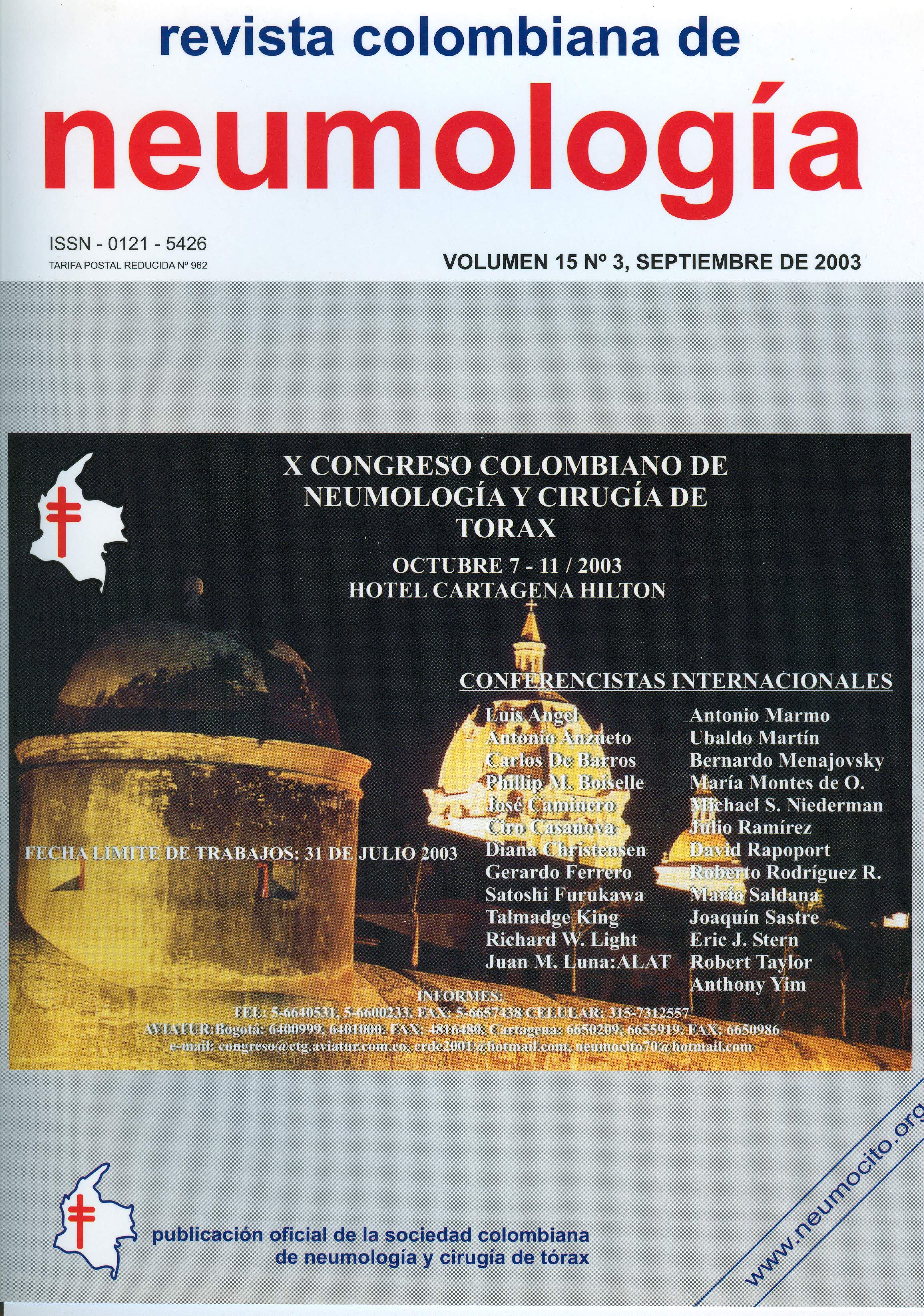Síntomas respiratorios en pacientes con cáncer pulmonar: una comparación del tiempo de consulta entre fumadores y no fumadores
Síntomas respiratorios en pacientes con cáncer pulmonar: una comparación del tiempo de consulta entre fumadores y no fumadores

This work is licensed under a Creative Commons Attribution-NonCommercial-ShareAlike 4.0 International License.
Ninguna publicación, nacional o extranjera, podrá reproducir ni traducir sus artículos ni sus resúmenes sin previa autorización escrita del editor; sin embargo los usuarios pueden descargar la información contenida en ella, pero deben darle atribución o reconocimiento de propiedad intelectual, deben usarlo tal como está, sin derivación alguna.
Show authors biography
Background: There is a controversy around the timing of diagnosis of lung cancer and it's relation with smoking habit. Objective: To compare the time with pulmonary indicator symptoms between smokers and non-smokers with lung cancer. Design: Case-series. Setting: Two hospitals in Bogotá, Colombia.
Patients and methods: In patients with a pathological diagnosis of lung cancer and identification of ce/Ju/ar type, we reviewed the time with respiratory indicator symptoms and compared it between groups defined by the plain chest X-ray location, TNM stage and smoking history.
Results: Complete data were acquired for 184 patients with mean age 60 years-old, 59% male gender, anda higher proportion of adenocarcinoma (38.3%) or tumours of the squamous cell type (33.2%). Duration of symptoms were lightly shorter in nonsmokers (16 weeks) than in smokers (21 weeks, p 0.040), without differences related to tumor location (central vs.peripherical) or stage in TNM classification.
Conclusions: Time to search medical care after the beginning of indicator symptoms is longer in smokers, suggesting a higher tolerance to respiratory symptoms and a probably "negative or reverse detection-signal bias", with potential implications for early diagnosis and screening programs.
Article visits 81 | PDF visits 45
Downloads
- Smith RA, Glynn T J. Epidemiology of lung cancer. Radio! ClinNorth Am. 2000; 38: 453-470.
- Anónimo. Cáncer Broncogénico. En Ramírez G, Patiño JF, Castro CJ (Editores) Guías de Práctica Clínica en Enfermedades Neoplásicas. Instituto Nacional de Cancerología, Bogotá DC. 2001; 271-288.
- Patz EF, Goodman PC, Bepler G. Screening for lung cancer. N Engl J Med. 2000; 343: 1627-1633.
- Yankelevitz DF, Henschke CI. Small solitary pulmonary nodule.Radio! Clin North Am. 2000; 38: 471-478.
- Park BJ, Louise O, Altorki N. Staging and the surgical management of lung cancer. Radio! Clin North Am. 2000; 38: 545-561.
- Wells CK, Peduzzi PN, Feinstein AR. Presenting manifestations, cigarrete smoking, and detection bias in age al diagnosis of lung cancer. Ann Epidemiol. 2001; 11: 239-247.
- Mountain CF. Revision in the lnternational System for Staging Lung Cancer. Chest. 1997; 111: 1710-1717.
- WHO: The World Health Organization histological typing of lung tumours, second edition. Am J Clin Pathol. 1982; 77: 123-136.
- Morón F, Meléndez P, Hidalgo JC, Carrillo J, Lastra G, Bonfante E, Gallego P, Martínez CE. Cáncer broncogénico, tipo celular y presentación radiológica, estudio multicéntrico en Bogotá, Colombia. Revista Colombiana de Radiología. 2001; 12: 1007-1012.
- Anónimo. IARC Monographs (Vol 83) Tobacco Smoke and lnvoluntary Smoking. (June 2002). Disponible en www.iarc.fr,
- Mcfarlane MJ, Feinstein AR, Wells CK, Chan CK. The 'epidemiologic necropsy'. Unexpected detections, demographic selections, and changing rates of lung cancer. JAMA. 1987; 258: 331-338.
- Henschke CI, McCauley DI, Yankelevitz DF, Naidich DP y cols. Early Lung Cancer Action Project: overall design and findings from baseline screening. Lancet. 1999 ;354: 99-105.
- Wells CK, Feinstein AR. Detection bias in the diagnostic pursuit of lung cancer. Am J Epidemiol. 1988; 128: 1016-1026.
- Koyi H. and Hillerdal G. Patient's and doctors' delays in the diagnosis of chest tumors. Lung Cancer. 2002: 35: 53 - 57.
- Ashley MJ, Cohen J, Bull S y cols. Knowledge about tobacco and altitudes toward tobacco control: how different are smokers and nonsmokers? Rev Canadienne de Sanie Publique. 2000; 91: 376-380.
- Frank E, Denniston M and Pederson L. Decline in smokers understanding of tobaccos hazards between 1986 and 1998, a report from north Georgia. South Med J. 2002; 95: 675-680.
- Silvestri GA, Zoller JS, Carter C and Bradford D. Current screening and health maintenance of never, former and current smokers: implications for mass screening to detect lung cancer. Am J Respir Crit Care Med. 2003; 167 (suppl): A 737.
- Kaetsu A, Fukushima T, Moriyama M, Shigematsu T. Smoking behavior and related lifestyle variables among physicians in Fukuoka, Japan: a cross sectional study. J Epidemiol. 2002; 12: 199-207.
- Barratt A, Mannes P, lrwing L y cols. Cancer screening. J Epidemiol Community Health. 2002; 56: 899-902.







